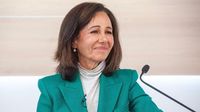Banco Santander is gearing up for a potentially landmark shareholders' meeting on April 4, 2025, where it aims to clarify its position among the financial elite by recovering a market capitalization of 100 billion euros for the first time since 2015. This moment comes as the bank has recorded an impressive revaluation of over 45% in 2025, showcasing resilience even amidst recent market fluctuations in the banking sector.
Institutional Shareholder Services (ISS), a global leader in governance solutions, has announced its backing for the bank’s new remuneration policies for the board of directors, which come in response to previous shareholder discontent regarding executive pay. This marks a crucial shift, especially after last year's shareholder meeting saw only 74% approval for the bank's pay policy—far below the 90% threshold achieved in prior years.
In the recent report, ISS expresses that while the proposed remuneration is largely agreeable, concerns remain regarding the high executive salaries. It specifically highlights the compensation for Ana Botín, the bank's executive chair, and Héctor Grisi, CEO, who currently receive significant salaries that have raised eyebrows among investors. Nevertheless, ISS advises a cautious vote in favor of the remuneration policy, noting improvements made following meetings with key investors that represent 24% of the bank’s capital.
From a historical perspective, the financial narrative for Banco Santander has been tumultuous. Ana Botín took the helm on September 10, 2014, during a time when the European Central Bank (ECB) was venturing into negative interest rates, a move unprecedented in banking history. By 2015, Santander found itself exceeding a market capitalization of 100 billion euros, buoyed by various financial strategies, including capital increases and bond issuances, necessary for liquidity reinforcements during the global financial crisis.
Fast forward to today, and the bank's trajectory paints a picture of recovery. After tumbling to a market capitalization around 30 billion euros in 2020, it has resurrected to a position where analysts note a strong likelihood of breaking the 100 billion euro mark again, aided by soaring profits and shareholders' renewed confidence.
Analysts are already buzzing about the profitability projected for Santander, with estimates suggesting the bank could surpass 12.69 billion euros this year, highlighting a remarkable turnaround from the less than 6 billion euros recorded in 2015. The stock price, as of March 24, 2025, is 6.54 euros, reflecting a healthy 1.52% increase from the previous day. In the past year, Santander’s shares have fluctuated, showing resilient growth—a reflection of a robust banking demand amid turbulent macroeconomic conditions.
As it stands, shareholders are keeping a close eye on these developments, weighing the implications of changes in interest rates and banking regulations that may affect the future. Despite currently being at a total gross profit of 63.49 billion euros, alongside net earnings of 12.57 billion euros, the dividend yield remains comparatively low at just 0.0342%. This aspect has led to ongoing discourse regarding how best to reward shareholders while maintaining strong growth metrics.
The strengthened market position of Banco Santander indeed does not come without significant external influences. Recent macroeconomic shifts, including changes in European inflation rates driven by defense expenditures and fiscal stimulus, have transitioned the bank's operational context significantly. Currently reaping benefits from higher interest rates, the wishful eye is on the regulatory landscape and its impact on future capital requirements.
Indeed, Barclays recently updated its target price for Santander’s shares to 7.50 euros, indicating a bullish sentiment among some analysts, while others remain more conservative with higher prices set in mind. All these factors lead to increasing optimism regarding Santander's stock, with forecasts suggesting it could aim toward reaching 6.85 euros per share in the near future.
Nonetheless, it’s essential to remain cautious, especially when observing technical analytics that show fluctuations and potential avenues for recovery or further drops. A careful monitoring process must be upheld to ensure that Santander remains on track to achieve and stabilize its market capital above the coveted 100 billion euro level.
The upcoming meeting will serve as a significant moment not only for shareholder sentiment but also for the broader financial landscape as it dynamically shapes perceptions of Banco Santander amidst its rivals in Europe, including BNP Paribas. With an increased focus on aligning executive pay with long-term performance incentives, the bank is set to navigate potentially challenging waters as it regains its footing in the market.
As the financial landscape evolves, both investors and the general public await April 4 with bated breath, wondering if this iconic bank can once again embrace its status in the upper echelon of European finance.






